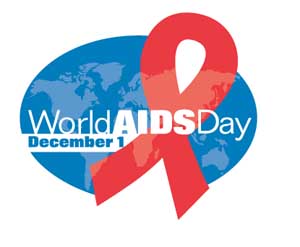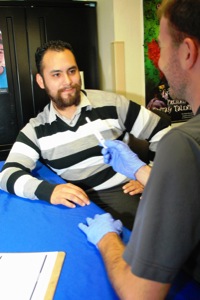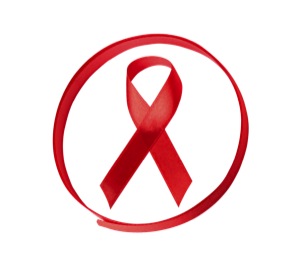
The world was catapulted into the fight against HIV and AIDS when the Centers for Disease Control reported the first documented cases in 1981. Seven years later, Dec.1 was designated as World AIDS Day. At Family Health Centers of San Diego (FHCSD), it is a day to reflect on the past, celebrate progress and rekindle our united fight to stop the spread of HIV/AIDS while caring for those living with the disease.
Reflecting on the past
In 1981, previously healthy young gay men started contracting a severe immune deficiency disease for which there was no known cure. In the first year, 270 people reportedly died from what would later be diagnosed as Human Immunodeficiency Virus (HIV) and Acquired Immunodeficiency Syndrome (AIDS) in the United States. Over the next 32 years, that number skyrocketed to 630,000 undiscriminating deaths in the United States and more than 25 million deaths worldwide.
The 1980s would be remembered as a time when the world first ignored the disease and then united to fight against it. Thousands died before community voices broke through the societal barriers previously unwilling to acknowledge that which they didn’t understand and wanted to ignore. HIV/AIDS advocates set the gold standard and soon, resources for surveillance, research, and care emerged. By 1988, the U.S. Health Services and Resource Administration provided grants to 11 states and 10 cities to plan for HIV/AIDS systems of care. These grants laid the groundwork for the statewide care programs funded by the Ryan White CARE Act of 1990.
FHCSD utilized the new federal funding to open the Ciaccio Memorial Clinic in Mission Beach in 1990. The clinic was named after John Ciaccio, a local LGBT activist and one of the first people in San Diego County to die from AIDS.
A few years later, FHCSD relocated Ciaccio Memorial Clinic to our new North Park Family Health Center, making it more convenient for patients and creating the County’s first HIV/AIDS one-stop, multi-discipline treatment, care, coordination and prevention services center. In 1998, FHCSD opened Hillcrest Dental Clinic to ensure people living with HIV/AIDS had access to high quality dental treatment and were not turned away due to ill-perceived stigmas around their disease.
The 2000s brought more advances in treatment as the highly complicated pharmaceutical “cocktails” were replaced by much simpler medication regimes with far fewer side effects.
Celebrating progress
Advances in care, treatment and prevention of HIV/AIDS since 1981 have been monumental.
Only 2 percent of babies born to HIV positive mothers who are undergoing active care and treatment contract the disease; down from a 25 percent occurrence when the mother is not treated.
Unlike the early days of the pandemic, blood transfusions and organ transplants in the United States are no longer considered significant risk factors for infection either. In fact, due to testing of blood donors and donated blood, the U.S. blood supply is among the safest in the world.
Testing has come a long way too. Today, HIV testing is available throughout San Diego. The two most common tests are the rapid test that provides results in 15-20 minutes following a non-invasive mouth swab, and the standard blood test, which may take up to a week to receive results. Both of these tests look for the presence of HIV antibodies, your body’s reaction to infection, and may not be positive until a month after infection. There is also an HIV Early Test, which uses a blood sample to detect HIV as early as 72 hours after infection. This test is available at limited locations, including FHCSD’s Tuesday/Thursday Night Clinic.

Today, life is also much better for those living with HIV/AIDS. With daily medication, regular laboratory monitoring and a healthy lifestyle (exercise, good diet, and eliminating bad habits like smoking), people living with HIV can enjoy a long and happy life.
Medical breakthroughs continue as well. A man in Berlin is considered “cured” of HIV following a complex bone marrow transplant that introduced a rare genetic mutation that blocks HIV from entering his cells. In a separate discovery, a three-year-old girl was “cured” of HIV following the use of a new drug cocktail. While promising, researchers are still analyzing both discoveries and a widespread cure is not expected for years, if not decades.
Rekindling the fighting spirit
With so much progress it is easy to forget that every year approximately 2 million people die from HIV/AIDS and 2.7 million people are newly infected worldwide. About 1.1 million people are living with HIV/AIDS in the United States today. Sadly, 18 percent of those don’t even know they are infected.
Gay, bisexual and other men who have sex with men (MSM) of all races and ethnicities remain the population group most profoundly affected by HIV. Injection drug users are at high risk as well.
“We have made great progress, but now is no time for complacency,” said Bob Lewis, FHCSD’s director of Special Populations. “As a community, we must continue to make sure that everyone living with HIV is aware of their status and in care, and that we all practice safe behaviors to prevent the future spread of HIV/AIDS.”
Dr. Christian Ramers shares a similar message of hope with a commitment to further progress.
“It’s pretty amazing how far we have come since 1981, but it’s also important to remember that the fight is not over,” said Dr. Ramers, FHCSD’s assistant medical director for Research and Special Populations.
Dr. Ramers grew up in San Francisco in the 1980s and the pandemic motivated him to earn his Masters in Public Health and become a physician with board certification in pediatrics, internal medicine and infectious disease.
“HIV is no longer a death sentence, but it is still essentially a life sentence and we need to continue our work to fight HIV and AIDS worldwide.”
As a community, we must also recognize that other factors like drug and alcohol abuse play a major role in the death of people with HIV/AIDS today.
“People trapped in the cycle of addiction lose control of their lives and their disease, which often leads to an early death,” said Duane Aubert, who manages substance abuse programs for FHCSD’s HIV Services Department.

Leander Robertson is a FHCSD intervention specialist and was diagnosed with HIV in 1988- the same year World AIDS Day was established. He thinks of his many friends who have died from the disease and those who continue their fight to live.
“When I was diagnosed it was still very early [in the pandemic]. Medications like AZT were available, but they had terrible side effects. It wasn’t easy and a lot of people died,” said Leander. “Today there is hope, but there is still a lot of room for progress.”
As the largest provider of HIV/AIDS testing, treatment, care and prevention services in San Diego County, FHCSD is here to help. If you have HIV and need treatment, please call us – there are many resources to cover the cost of your care. If you don’t know your status – we offer free and confidential testing. Our dedicated team is in this fight to win. Until there is a cure, we will not let up and we will not waiver, because like you, we care.
For more information about Family Health Centers of San Diego, please visit fhcsd.org or call 619-515-2449 to schedule an appointment.











